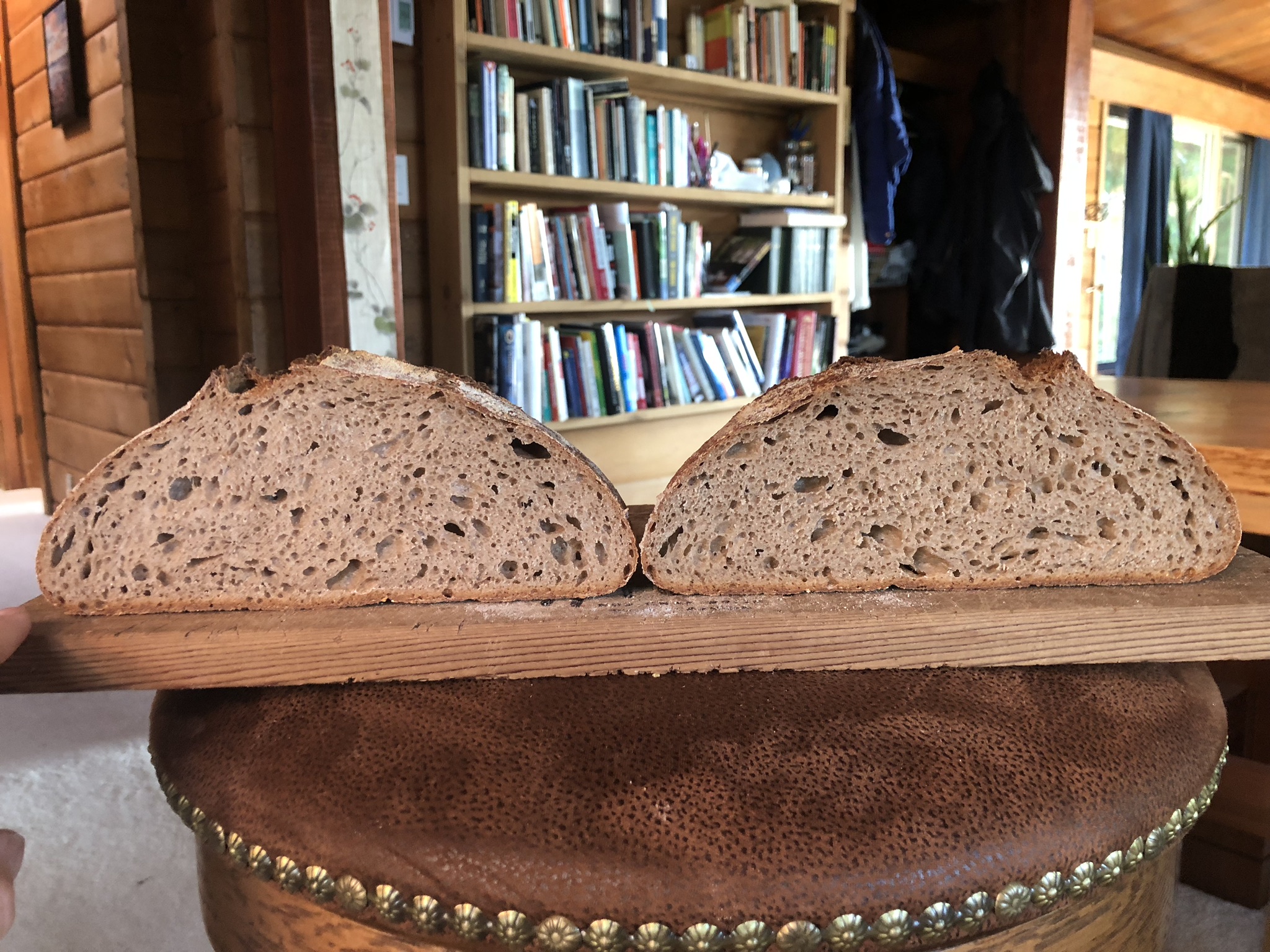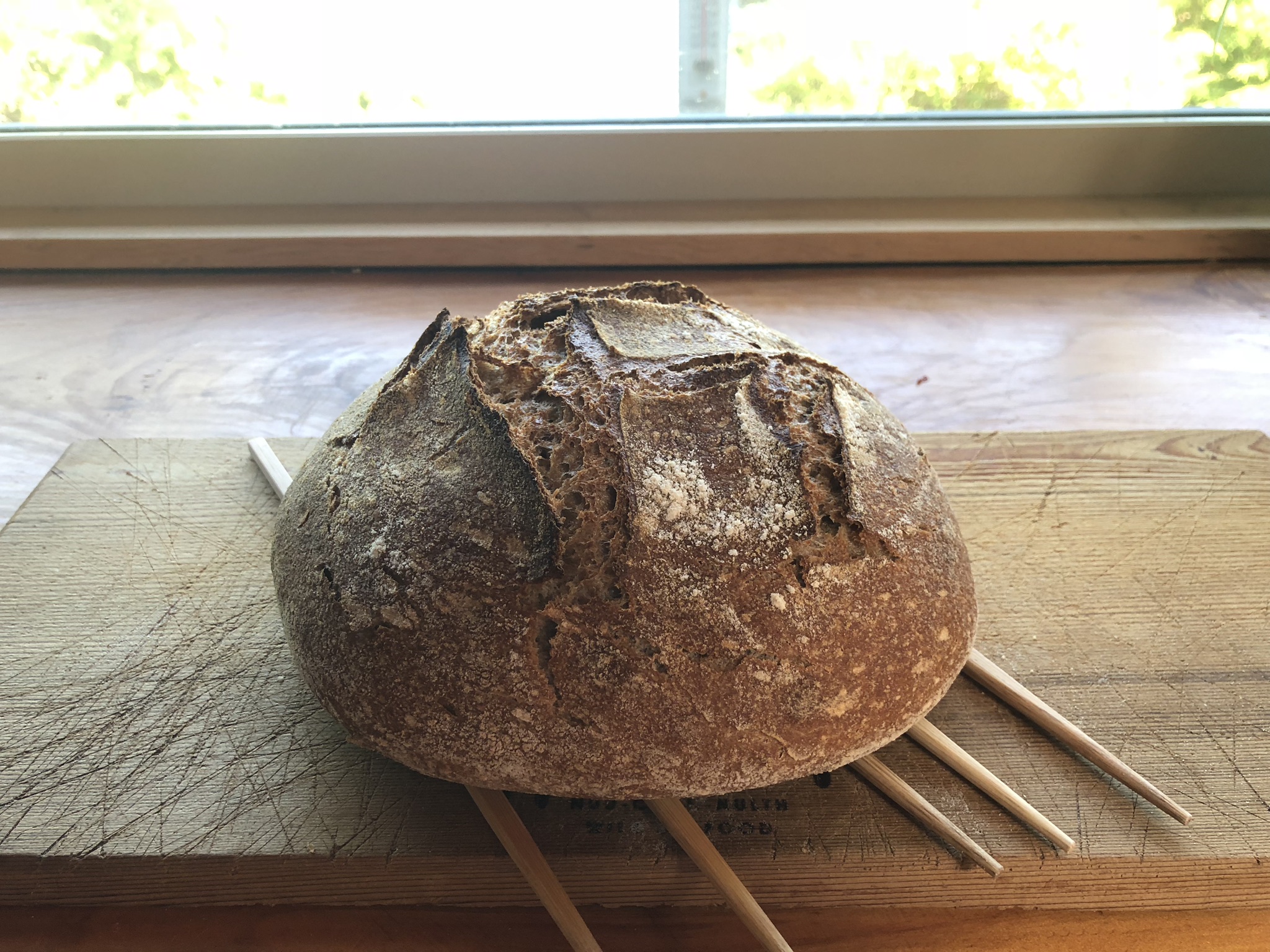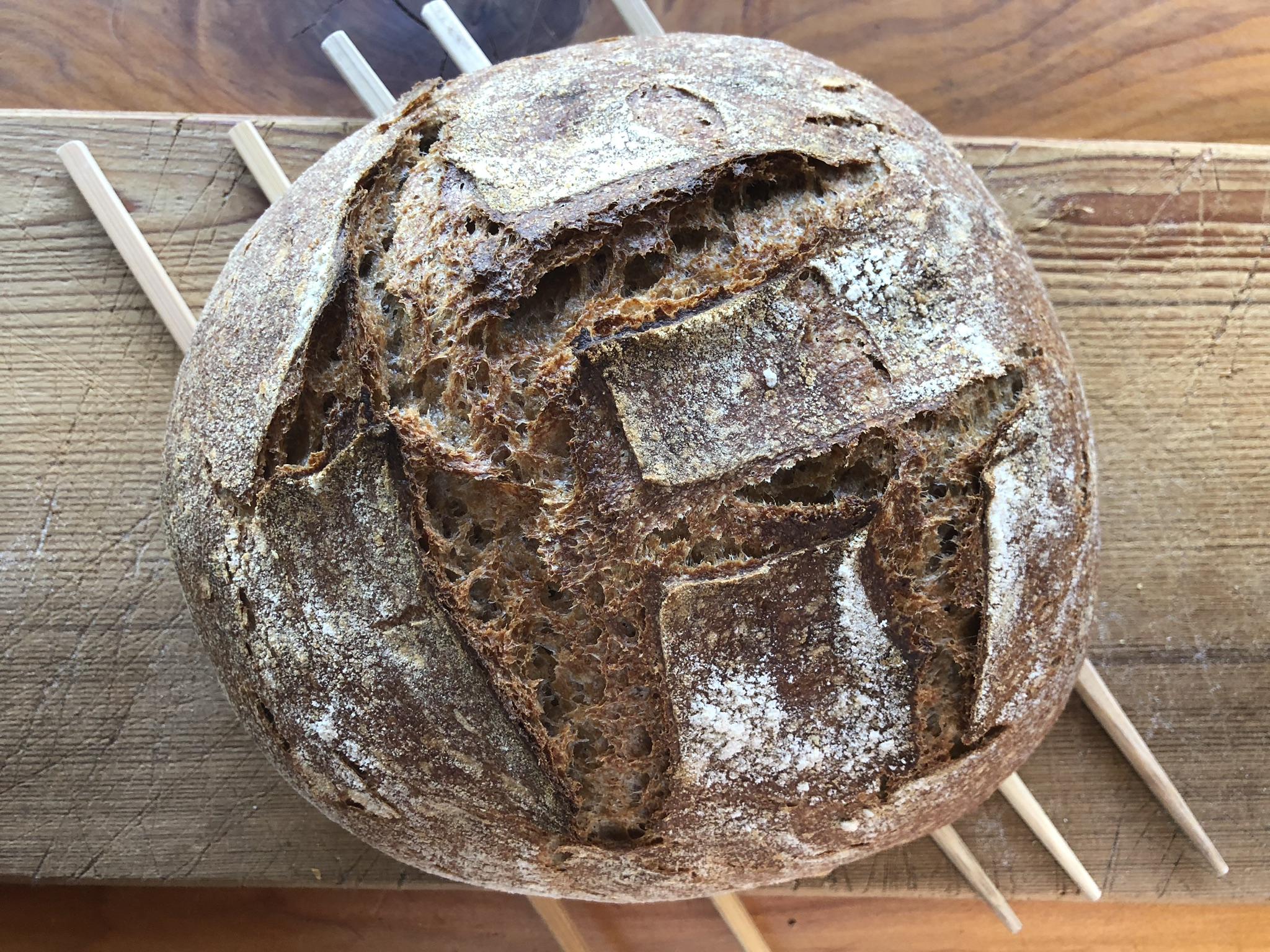I'm going to list some granular details for the learning process and feedback.
- 100% fresh-milled, organic, whole grain. 85% Red fife. 15% Rye.
- 10% fermented flour. Red Fife, NMNF starter, 3 refreshes, 36 hour fridge retard. 100% hydr.
- 85% hydration dough.
- 1.8% sea salt.
- Finely ground flour still warm from the Grainmaker hand-cranked mill.
- 50 min AL.
- Starter gets a stir and warms for 1 hour before mix.
- Add starter + salt to dough let rest 10 min.
- 150 SL&F. Shape to loose boule, Cover. 10 min rest. 150 more. Transfer to bowl.
- Bowl tugs, smoothing it out creating a bit of surface tension.
- 3 x ST&F every 20 min for an hour.
- 2 - 4 more ST&F every 30-45 min.
- About a 3.5 hour total bulk ferment from the time starter was added after AL.
- Pre-shape w/ bench knife. 15 min rest. Fold and shape and tx to rice floured banneton.
- Bagged (no towel on top) for 10 hour fridge retard 3c.
- Loaf sat on counter in the morning for 30 min but may not matter as it likely takes a while for dough to start warming and an increased rate of fermenting.
- No parchment paper tx--cold dough stays pretty stable on the hand.
- Spritzed dough.
- 475 preheat w/ DO. Corn floured bottom of dough. Hop scotch score. 20 min covered. Reduce to 425. 15 min uncovered. Check with a tap on bottom of loaf. Gave it 5 min more.
- 6 hour cool.
Tastes good but I'm not great at picking up subtle differences between loaves. I wouldn't change the aesthetic of the loaf. The alveoli development is where I'd like it to be--moderately open but good for toast with toppings. I got dramatically more rise and bloom this time. The last loaf I made was similar but 90% hydration. I liked how moist it was even compared to the 85%, it seemed detectable.
Things to note:
- It would be interesting to measure the water loss during SL&F. I would bet it's significant compared to a dough made with bowl-ST&F. I felt like I beat some water out of it. Any thoughts?
- I changed a few things from my last posted loaf: starter is Red Fife instead of Rye, 5% less water, SL&F, much better dough handling--I'm not sure what made the most difference.
- I shaped using mainly by scraper which made a huge difference to the integrity of the dough. Thanks to whomever posted the SFBI high-hydration vid. It was pivotal.
- I spritzed the dough a few times after the tx to the DO before I covered it but the small blisters did not show. Any thoughts?
- The dough in the banneton after a 9 hour retard looked unmoved. I though for sure it was a dud. This was very surprising to me that it sprung so much. I definitely have lots to learn on this specific loaf, never mind other loaves. I think I suck at estimating how much a dough has rise during bulk and proof.
For next time:
- Head back up to 90% hydr. I want a really moist crumb and hope that will make the difference.
- Does 500d for 20m vs 450d for 20m affect crumb dryness if they are both cooked to the same internal temp?
- Why did my spritz not bubble?
- This is a pretty labour intensive loaf. I'm wondering what I can pare down. I'll eventually try less SL&F, only 2 refreshes of the starter, etc., trying to get the same quality with a bit less time, even though I enjoy it.
I welcome any tips and thoughts.
Thanks for the help, TFL.
-Tom



Nice loaf. I have never used red fife, so can't help with much of the questions. If you want to know the water loss from the SL & F, just weigh it before you start S L & F and weigh it again when you are done.
Looks like a perfect openness for sandwiches or spreading butter.
In terms of general cooking theory, as you increase the oven temp, you increase the differential temperature in the loaf. That is, if you baked it at 500, once the very center got to 205, the parts closest to the crust would be drier than if you baked it at 450 and the center got to 205.
"It would be interesting to measure the water loss during SL&F. I would bet it's significant compared to a dough made with bowl-ST&F. I felt like I beat some water out of it. Any thoughts?"
I did my first slap and fold today. 100% WW, 100% Hydration. I kept thinking, my wood counter must be sucking up a lot of the moisture. The slap and fold worked great, my dough was easy to work with. I am going to do a writeup on it after it bakes and is sliced. If the slap and fold drops the hydration 5% due to water loss, then, that would be good to know. I wish I had a non-porous counter I could execute the slap and fold on.... wait, I think I do! I'll have to try that!
Measuring the dough is tricky, because I lose a decent amount of the dough that sticks to my hand in between stages.
you might take a look at my recent forum post: http://www.thefreshloaf.com/node/56881/those-100-whole-wheat-no-gluten-mission
It's almost completely hands-off with no stretch and fold, slap and fold and kneading at all. And yet still produced a decent loaf.
significant water loss during slap and fold. I suspect a lttle obviously as there is a little splatter but 5% or greater would surprise me.
i will see what others find out, and if no one else posts I will try to remember on my next bake.
I really like your loaf, BigBlue, love the appearance and crumb looks really good. to make it easier, you can probably reduce the nos of stretch and folds during BF as I think you would have built most of your strength earlier.
Leslie
I've never used Red Fife so can't talking about how thoisty it is but it fresh filled so it will be thirsty and it is a hard red wheat too.
even though killer, for a better crumb, yes it can be better, you need to do a bran levain and increase the autolyse to 2 hours for the high extraction flour and up the hydration.. (5% should be no worries,
Spriting white bread makes for big blisters. I will bet there are millions of little tiny ones this bread though because mine always has them.
Hard to improve on the outside but if you want a thinner, less crunchy crust, you can play with the temperature say bake at 450 F to start and not spritz or even 435 F.ot r less time for steam 18 instead of 20 minutes or some combination.
That is great oad of bread. Now it is time to take it up to the Strutting Peacock Fan Fabulous
Now we have bowl tugs - Jeeze man! You can't use that . Come up with a great name for it that is perfectly descriptive like Sleeping Ferret Fold is. or Strutting Peacock Fan Fabulous above!
Haha I heard Justin Burton at the Stella Culinary Podcast use "bowl tugs". I like it.
OK next loaf is 90% hydr. I'll do the 2 hour AL as you recommend. Not going to sift this time but will keep it in mind. In addition to my NMNF Red Fife 66% hydr starter which is a few weeks old in the fridge now, I'm going to bulk ferment at 32c which should give the Lab a head start and contribute to a more sour loaf.
Thanks for the pointers. Always appreciated.
When you increase the temperature to give LAB a head start it also restricts the yeast but even more importantly you also increase the enzyme catalytic activity. Every 18 F increase doubles the action of amylase and protease. and the additional autolyse does the same thing, so you may end up with something you don't like:-) WHOLE GRAINS HAVE HUGE PILES OF ENZYMES TO BEGIN WITH COMPARED TO WHITE FLOUR. Things will happen very, very fast fast so pay close attention. Just know you are doing things all in one direction and that direction will be on steroids. I prefer to increase the LAB to yeast ratio in starters and levains and do the dough work at room temperatures in my case 80 F with AC on right now. I'm not saying don't do it but be on your toes to make sure your experiment has the best chance for success.
I don't think my loaves taste very sour and I'm already 100% WG with a proof retard. I'm interested to find out if the loaves get more sour as my NMNF retarded starter ages. Whole grains contributed more to sour than the other variable. But I smell some white flour SD loaves that are pungently sour. Maybe they are using vinegar or something. If I want more sour w/o sacrificing rise and a medium open crumb and while using an 85% wheat, 15% rye, should I increase the amount of levain from the 10% prefermented flour I'm already using? I'm already doing a 9 hour fridge retard. Should I bulk retard and proof retard? Should I cultivate my levain from the NMNF starter at 32c over 12 hours?
Thanks.
she does an online course - Udemy has it, not sure if it is available elsewhere where she does cover this topic. I am not interested in sour bread so haven't tried it, but she has lots of courses at least one would help you. Dabrownman is of course our own source of invaluable info but if you want another perspective it is maybe worth a look.
Leslie
I paid for the Greenway course on sour, and was not all that impressed - in part because it only dealt with white flour, and in part what she suggests is a secret is actually information fairly widely available. I would suggest your start here https://brodandtaylor.com/make-sourdough-more-sour/
LAB toi yeast ratio possible. But when you only use 10 of it in a bread, even though it is the best place to start if your wee beasties are good ones for sour, it is way more important what happens to the levain and dough itself when it comes to sour. Increasing the LAB toi yeast ratio there is way more important than the NMNF starter.
Good Luck